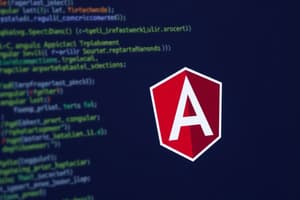Podcast
Questions and Answers
What is the role of a component in Angular applications?
What is the role of a component in Angular applications?
- To manage navigation between different views
- To provide a piece of user interface and contain a template, class, and metadata (correct)
- To format and transform data before rendering
- To manipulate the DOM by adding or removing elements
Which function does a directive primarily serve in an Angular application?
Which function does a directive primarily serve in an Angular application?
- To serve as a singleton object for sharing functionalities
- To facilitate routing between different views
- To store and retrieve data from external systems
- To influence the structure and behavior of the DOM elements (correct)
Which of the following best describes a pipe in Angular?
Which of the following best describes a pipe in Angular?
- A directive used for adding event listeners to elements
- A function for transforming data directly within templates (correct)
- An object that provides backend services to components
- A mechanism for defining navigation routes in the application
What is the primary purpose of a service in Angular?
What is the primary purpose of a service in Angular?
Which component is essential for managing navigation in an Angular application?
Which component is essential for managing navigation in an Angular application?
Flashcards are hidden until you start studying
Study Notes
Components
- Building blocks of Angular applications
- Represent a piece of user interface (UI)
- Consist of:
- Template (HTML)
- Class ( TypeScript)
- Metadata (decorator)
- Can contain other components (nesting)
- Can communicate with each other through:
- Property binding
- Event binding
- Services
Directives
- Instructions in the template that manipulate the DOM
- Can be:
- Component directives (e.g.
ngComponentOutlet) - Attribute directives (e.g.
ngClass,ngStyle) - Structural directives (e.g.
ngIf,ngFor)
- Component directives (e.g.
- Used to:
- Add or remove elements from the DOM
- Change the appearance or behavior of elements
- Respond to user input
- Can be custom-built or used from the Angular framework
Pipes
- Functions that transform data in the template
- Used to:
- Format data (e.g. dates, currencies)
- Filter data (e.g. sorting, filtering)
- Convert data types
- Can be:
- Built-in pipes (e.g.
json,async) - Custom-built pipes
- Built-in pipes (e.g.
- Used in the template with the
|symbol (e.g.{{ value | json }})
Services
- Singleton objects that provide a specific functionality
- Used to:
- Share data between components
- Perform complex operations
- Interact with external systems (e.g. APIs)
- Can be:
- Injected into components using dependency injection
- Used as a provider for other services
- Examples: logging, authentication, data storage
Routing
- Mechanism for navigating between views in an Angular application
- Uses the URL to determine which view to display
- Consists of:
- Routes configuration (e.g.
app-routing.module.ts) - Route parameters (e.g.
:id) - Route guards (e.g. authentication)
- Routes configuration (e.g.
- Can be used to:
- Create a navigation menu
- Dynamically load components
- Preserve application state between views
Components
- Angular applications are built using components, which represent a piece of user interface (UI)
- A component consists of a template (HTML), a class (TypeScript), and metadata (decorator)
- Components can contain other components (nesting) and communicate with each other through property binding, event binding, and services
Directives
- Directives are instructions in the template that manipulate the DOM
- There are three types of directives: component directives, attribute directives, and structural directives
- Directives are used to add or remove elements from the DOM, change the appearance or behavior of elements, and respond to user input
- Examples of built-in directives include
ngClass,ngStyle,ngIf, andngFor
Pipes
- Pipes are functions that transform data in the template
- Pipes are used to format data (e.g. dates, currencies), filter data (e.g. sorting, filtering), and convert data types
- There are built-in pipes (e.g.
json,async) and custom-built pipes - Pipes are used in the template with the
|symbol (e.g.{{ value | json }})
Services
- Services are singleton objects that provide a specific functionality
- Services are used to share data between components, perform complex operations, and interact with external systems (e.g. APIs)
- Services can be injected into components using dependency injection and used as a provider for other services
- Examples of services include logging, authentication, and data storage
Routing
- Routing is a mechanism for navigating between views in an Angular application
- Routing uses the URL to determine which view to display
- A route configuration defines the routes in an application (e.g.
app-routing.module.ts) - Route parameters (e.g.
:id) and route guards (e.g. authentication) can be used to customize routing behavior - Routing can be used to create a navigation menu, dynamically load components, and preserve application state between views
Studying That Suits You
Use AI to generate personalized quizzes and flashcards to suit your learning preferences.




